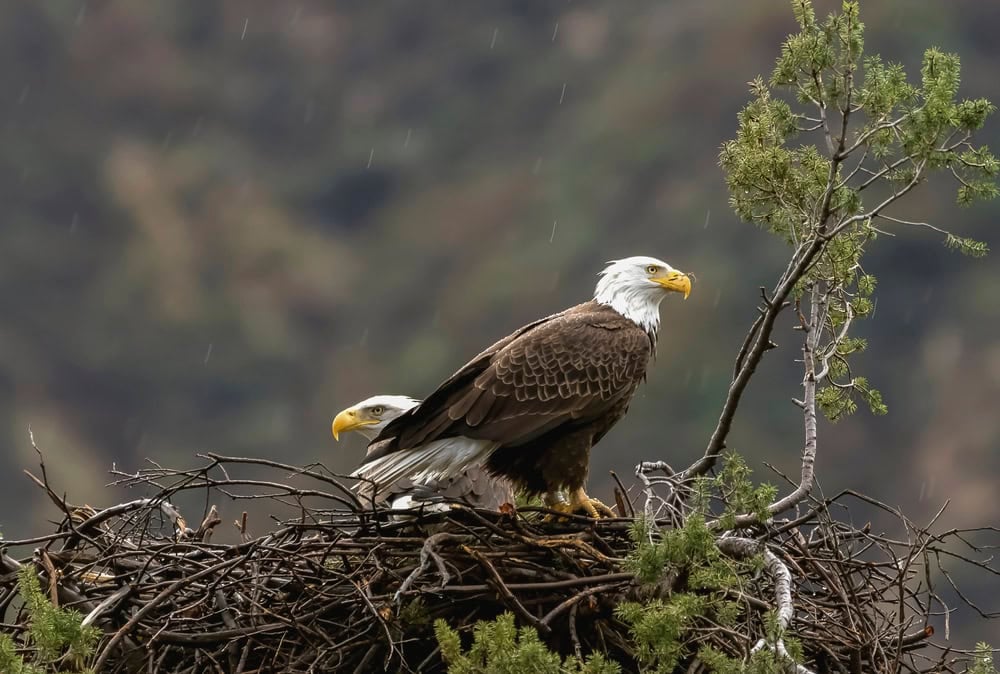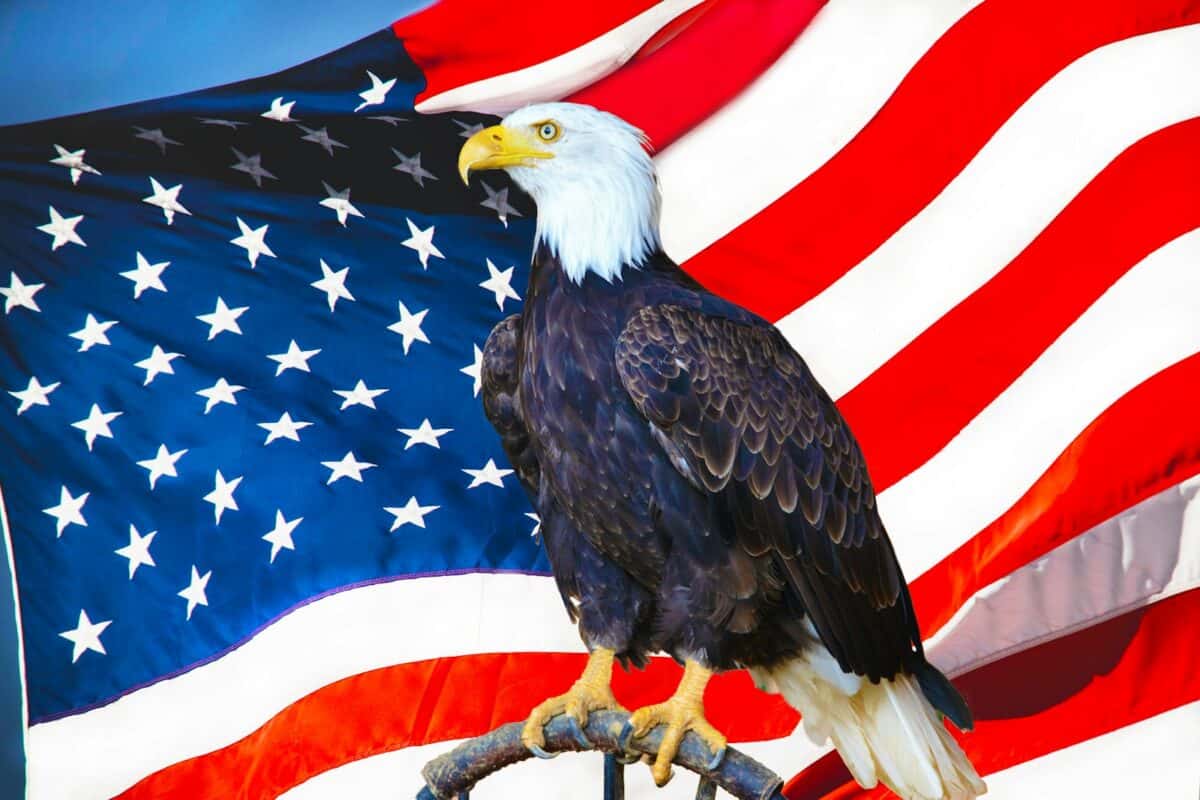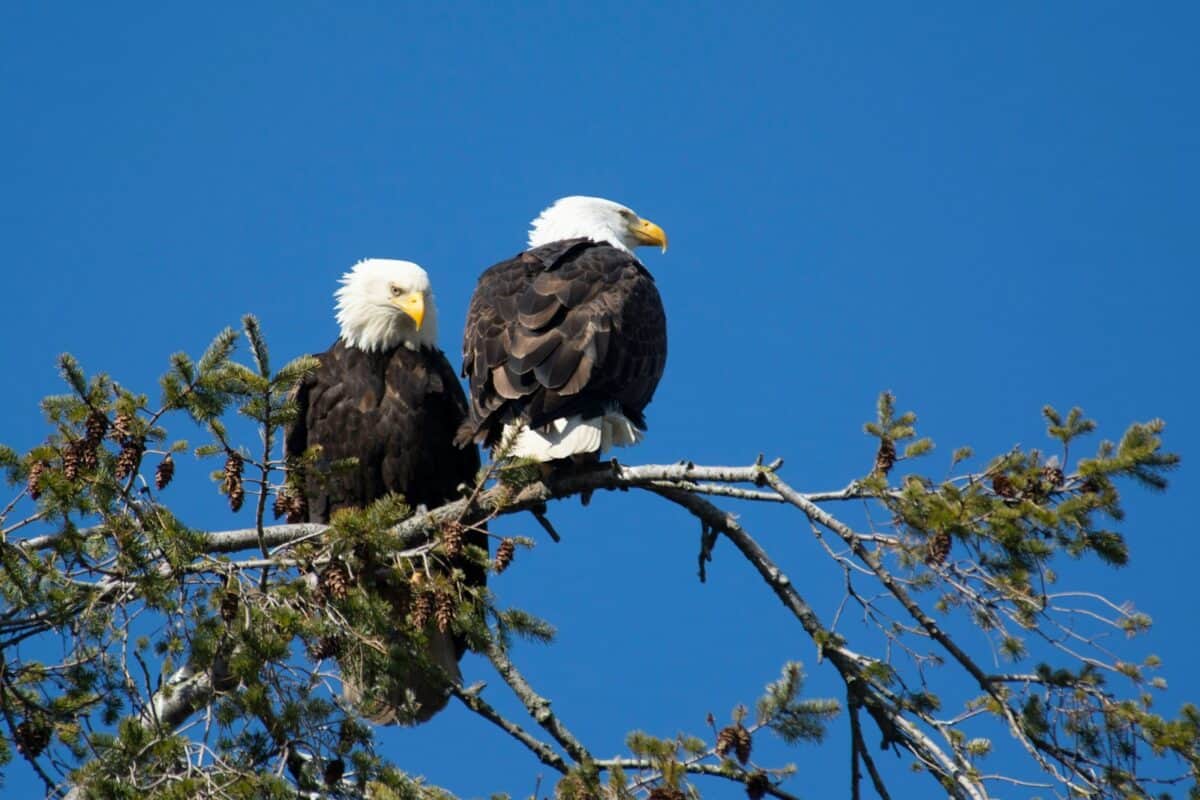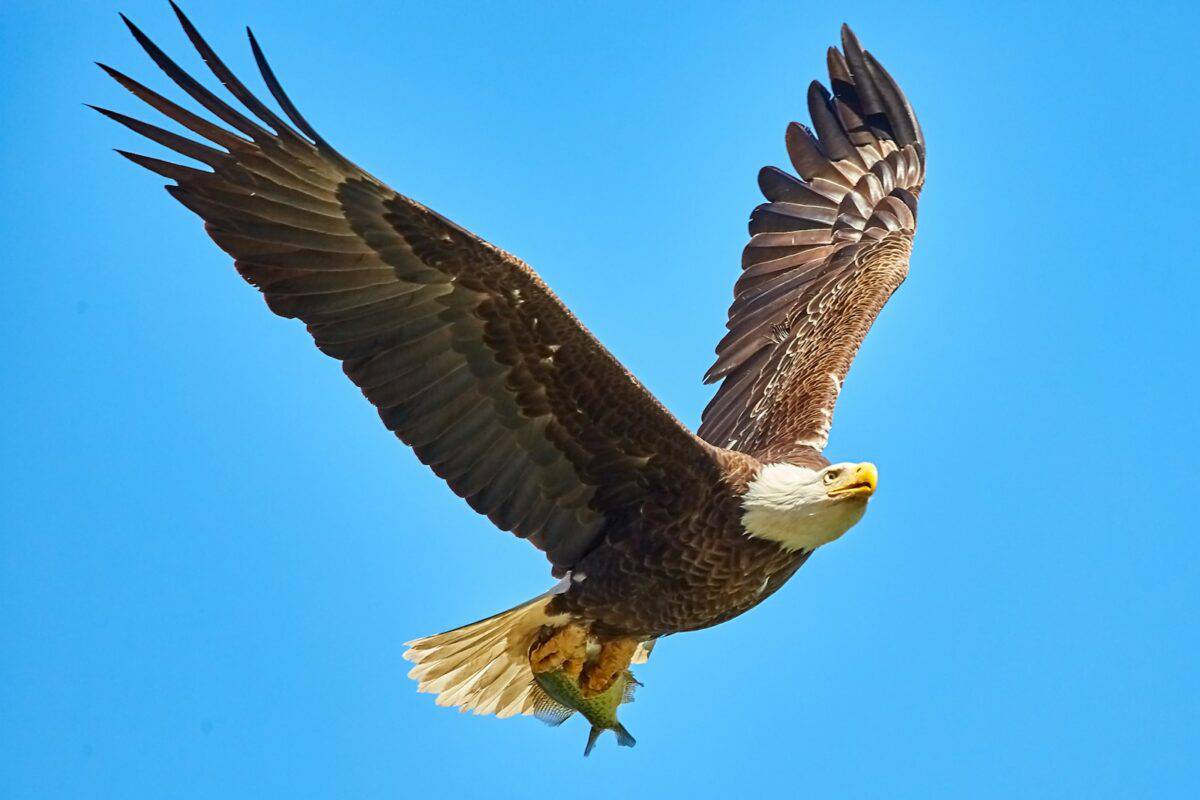The American Bald Eagle stands as one of the most iconic symbols of freedom and strength in the United States. With its striking white head, powerful yellow beak, and impressive wingspan, this magnificent bird of prey has captured the imagination of Americans for generations. Once endangered due to hunting and pesticide use, the bald eagle has made a remarkable comeback, teaching us valuable lessons about conservation and perseverance. In this article, we’ll explore fourteen fascinating facts about this majestic national bird, from its impressive physical characteristics to its unique behaviors and historical significance.
National Symbol Since 1782

The bald eagle was officially adopted as the national emblem of the United States on June 20, 1782, when it was placed on the Great Seal of the United States. Congress chose this magnificent bird because of its strength, majestic appearance, long life, and native status to North America. Interestingly, Benjamin Franklin famously opposed this selection, preferring the wild turkey as he considered the eagle “a bird of bad moral character” due to its scavenging habits. Despite Franklin’s objections, the bald eagle has remained America’s national bird for over 240 years, appearing on official documents, currency, flags, and government buildings throughout the nation.
Not Actually Bald

Despite its name, the bald eagle is not bald at all. The name originates from an old English word “balde,” meaning white, referring to the distinctive white feathers covering the head and tail of adult bald eagles. These white feathers create a striking contrast against their chocolate-brown body and wings, making them one of the most recognizable birds in North America. Young bald eagles lack this distinctive appearance until they reach maturity around 4-5 years of age, when they develop the iconic white head and tail feathers that have made them famous.
Impressive Size and Wingspan

Bald eagles are among the largest birds of prey in North America, with females typically larger than males. They stand about 30-43 inches (76-110 cm) tall, with an extraordinary wingspan ranging from 6 to 8 feet (1.8 to 2.4 meters). Female bald eagles can weigh up to 14 pounds (6.4 kg), while males typically weigh around 9 pounds (4.1 kg). This sexual dimorphism—where females are larger than males—is common among birds of prey. Their massive wingspan allows them to soar effortlessly on thermal currents, sometimes reaching altitudes of 10,000 feet (3,048 meters) and speeds of up to 35-43 mph (56-69 kph) in level flight.
Extraordinary Vision

Bald eagles possess some of the most powerful eyes in the animal kingdom, with vision estimated to be four to eight times stronger than that of humans. Their eyes are nearly the same size as human eyes but in a much smaller skull, giving them a disproportionately large appearance. Eagles can see clearly about eight times farther than humans can, allowing them to spot prey from remarkable distances—up to 2 miles (3.2 km) away. Additionally, they can see ultraviolet light and can look straight into the sun thanks to specialized eyelids that filter intense light. This exceptional vision is crucial for hunting fish and other prey from high in the sky.
Masters of the Water

Bald eagles have a strong affinity for aquatic environments, typically living near rivers, lakes, marshes, and coastal areas where fish are abundant. Fish comprise about 70-90% of their diet, and they are remarkably skilled fishers. Using their powerful talons, bald eagles can dive at speeds up to 100 mph (160 kph) to snatch fish swimming near the water’s surface. Interestingly, they can only carry prey weighing about 4-5 pounds (1.8-2.3 kg), which is less than half their body weight. If they catch a heavier fish, they may “swim” to shore using powerful wing strokes, sometimes dragging the fish for hundreds of yards to reach land where they can consume it.
Opportunistic Hunters and Scavengers

While primarily fish-eaters, bald eagles are opportunistic feeders that adapt their diet based on availability. Beyond fish, they hunt waterfowl, small mammals, and reptiles. They’re also known to be efficient scavengers, often stealing prey from other birds (particularly osprey) or feeding on carrion along roads or at landfills. This behavior, known as kleptoparasitism, allows them to conserve energy by letting other predators do the work of catching prey. Their opportunistic nature helped them survive during lean times and contributed to their recovery as a species, though this scavenging behavior was part of what Benjamin Franklin criticized when arguing against the eagle as a national symbol.
Impressive Nests

Bald eagles build the largest nests of any North American bird, creating structures that are truly architectural marvels. Their nests, called eyries, are typically built high in tall trees near water sources and can measure up to 13 feet deep, 8 feet wide, and weigh over a ton (2,000 pounds). What makes these nests even more remarkable is that eagle pairs return to the same nest year after year, adding new materials each breeding season. One famous eagle nest in St. Petersburg, Florida, was used continuously for 30 years and reached a weight of over 4,400 pounds (2,000 kg) before the tree collapsed. These massive nests serve as both nurseries for eaglets and as year-round homes in regions where eagles don’t migrate.
Lifelong Partnerships

Bald eagles are generally monogamous, mating for life unless one partner dies. Pairs engage in spectacular courtship rituals that include elaborate flight displays where they lock talons in mid-air and spiral toward the ground, separating at the last moment in a breathtaking demonstration of trust and coordination known as a “cartwheel display.” Both parents share responsibilities in raising their young, from incubating eggs to feeding eaglets. Eagle pairs work together to defend their territory, which can span 1-2 square miles. Their strong bond contributes to their reproductive success, with some pairs remaining together for over 20 years. However, if breeding attempts fail repeatedly, eagles may find new mates.
Remarkable Recovery from Near Extinction

The bald eagle’s recovery represents one of the greatest conservation success stories in American history. In the mid-20th century, bald eagle populations plummeted due to hunting, habitat destruction, and most significantly, the widespread use of the pesticide DDT, which caused eagles to lay eggs with shells too thin to support developing embryos. By 1963, the population had crashed to just 417 known nesting pairs in the lower 48 states. Their protection under the Endangered Species Act of 1973, combined with the banning of DDT, allowed populations to gradually recover. By 2007, bald eagles had recovered sufficiently to be removed from the endangered species list, with current estimates suggesting over 316,700 bald eagles now live in the continental United States, a truly remarkable comeback.
Powerful Vocal Communicators

Despite their fierce appearance, bald eagles don’t produce the powerful, screaming call often attributed to them in movies and television. The sound commonly used in media is actually that of a red-tailed hawk. In reality, bald eagles communicate using a series of high-pitched whistling or piping calls that might seem surprisingly weak for such an imposing bird. Their most common call is a series of short, piercing, staccato notes that sound like “kee-kee-kee.” These vocalizations serve multiple purposes, from territorial declarations to coordination between mates during nesting and hunting. Eagles are most vocal during breeding season, using distinct calls for different situations, including warning of threats and communicating with their young.
Impressive Longevity

Bald eagles are remarkably long-lived birds, surviving up to 20-30 years in the wild and even longer in captivity. The oldest confirmed wild bald eagle was at least 38 years old when it was hit and killed by a car in New York in 2015. It had been banded in New York state in 1977. In captivity, eagles can live even longer, with some individuals reaching more than 50 years of age. Their impressive lifespan contributes to their ability to produce many offspring throughout their lives. However, only about 50% of eaglets survive their first year, facing threats from predators, disease, and learning to hunt effectively. Those that reach adulthood typically have high survival rates, barring human-related threats like vehicle collisions, lead poisoning, or habitat destruction.
Legal Protections

Bald eagles remain among the most legally protected birds in the United States, even after their removal from the endangered species list. They are protected by multiple federal laws, including the Bald and Golden Eagle Protection Act of 1940, which prohibits anyone from harming, disturbing, or possessing eagles, their nests, or eggs without special permits. Violations can result in hefty fines up to $100,000 and potential imprisonment. Additionally, the Migratory Bird Treaty Act and the Lacey Act provide further protections. These laws have been instrumental in the species’ recovery and continue to safeguard eagles from human interference. One interesting exception exists for Native American tribes, who can apply for permits to possess eagle feathers for religious and cultural purposes through the National Eagle Repository.
Cultural Significance Beyond America

While the bald eagle is strongly associated with the United States, its cultural significance extends to many indigenous North American cultures, where it has been revered long before European colonization. For many Native American tribes, the eagle is considered a sacred messenger between humans and the divine, with its feathers among the most powerful and sacred items used in religious ceremonies and regalia. The Pueblo people associate eagles with the energies of the sun and the direction of the east, while the Navajo see them as powerful mountain spirits. In the Pacific Northwest, eagle motifs feature prominently in the traditional art of tribes like the Tlingit, Haida, and Tsimshian. This deep cultural reverence preceded and exists independently of the bird’s adoption as an American national symbol.
Unusual Physical Adaptations

Bald eagles possess several remarkable physical adaptations that make them exceptional predators. Their beaks, while seemingly simple, are specialized tools featuring a sharp, hooked tip that can tear through tough flesh and specialized serrations called tomia that act like built-in steak knives. Their talons exert an incredible crushing pressure of about 400 pounds per square inch (psi)—enough to pierce through the skull of prey or break a human arm. Eagles also have specialized foot scales and spicules (small bumps) on their footpads that help them grip slippery fish. Perhaps most impressive is their ability to voluntarily lock their talons onto prey using a ratchet-like mechanism in their tendons, allowing them to maintain a death grip without continuous muscular effort—an adaptation that enables them to carry heavy prey over long distances without tiring.
Conclusion: The Enduring Legacy of America’s Bird

The American Bald Eagle represents far more than just a national symbol; it embodies a remarkable conservation triumph and serves as a living reminder of the importance of environmental stewardship. From the brink of extinction to its current thriving population, the bald eagle’s journey mirrors America’s own story of resilience and redemption. As we continue to face new environmental challenges, the eagle’s recovery provides hope that with dedicated protection efforts and sound science, we can reverse damage to wildlife populations. Whether soaring high above wilderness areas or featured on national emblems, the bald eagle continues to inspire awe, respect, and a sense of national pride, ensuring its place not just in America’s ecosystems but in its cultural identity for generations to come.
- 12 Wildest Animal Myths That Are True - August 22, 2025
- 11 Species Reintroduced to U.S. Parks - August 22, 2025
- 12 Animals That Change Color You Never Knew About - August 22, 2025

